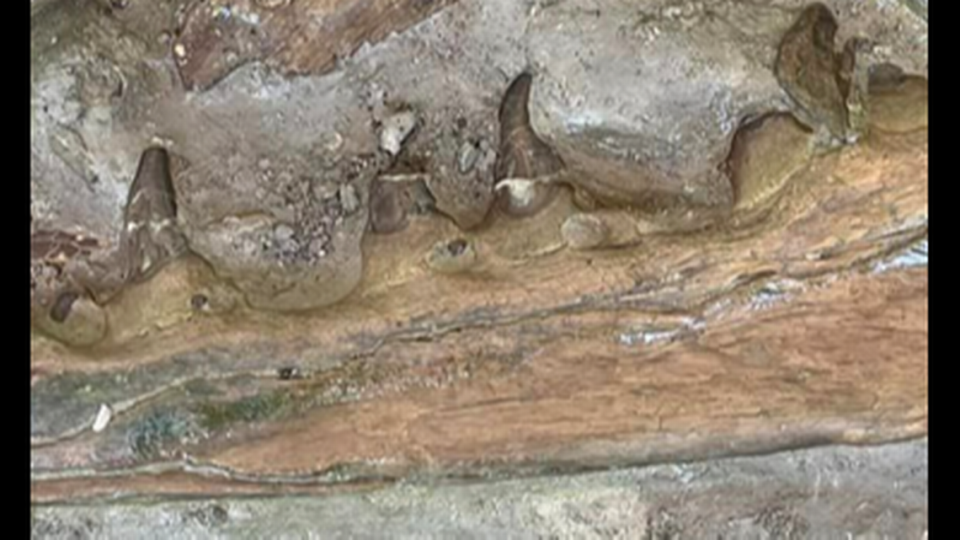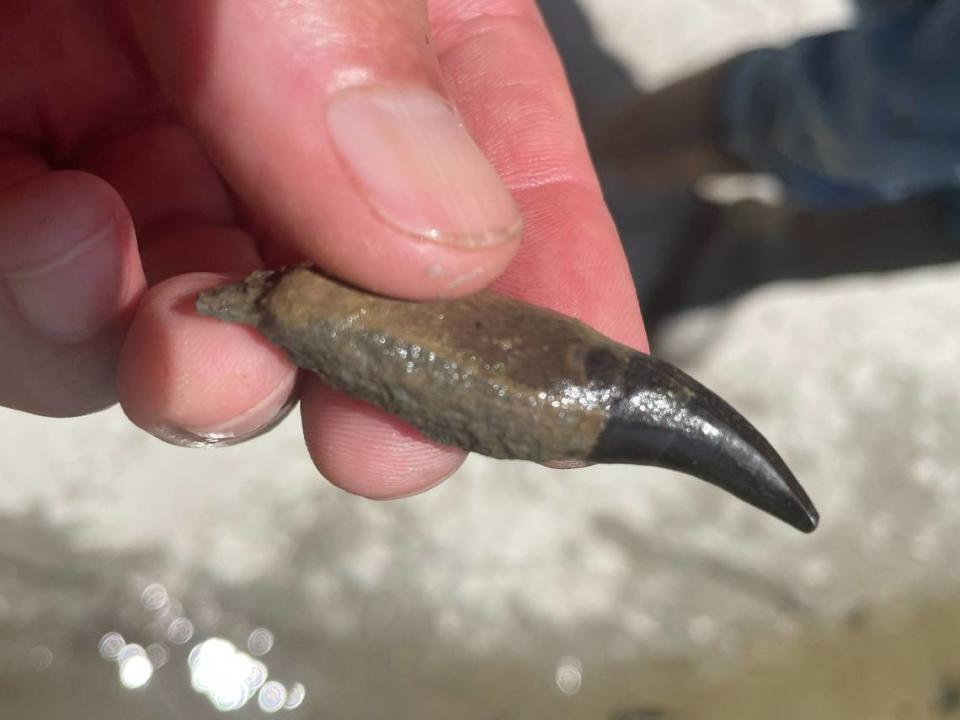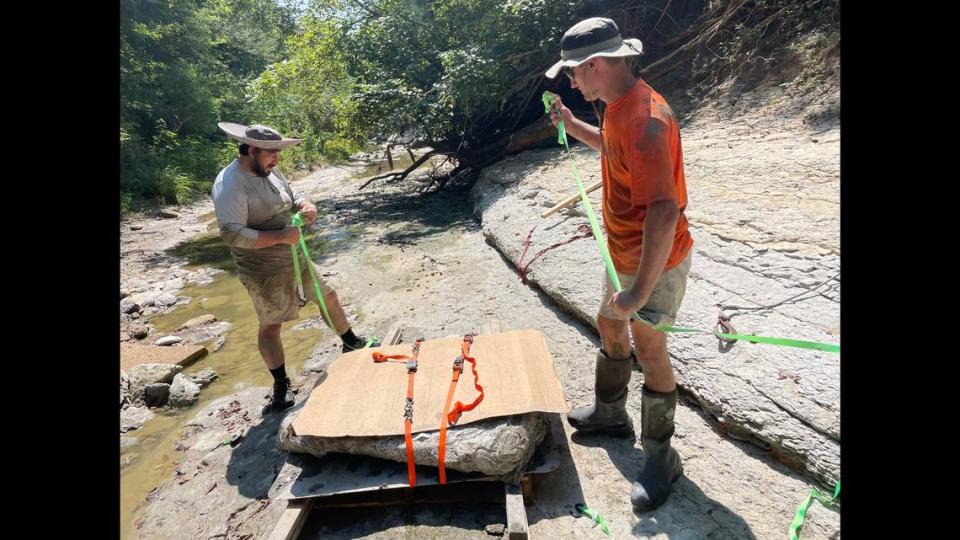4-foot skull found in Mississippi ravine belonged to ancient ‘sea dragon,’ experts say
A terrifying 4-foot-long skull — with its giant teeth still attached — has been found in Northeast Mississippi by a paleontologist who literally stepped over it.
George Phillips recalls he was standing in a creek, hollering for his wife to join him, when he found what amounts to a prehistoric sea monster.
“I looked down ... only to be amazed at what I had just stepped across — the broken remains of a mosasaur’s skull and neck,” said Phillips, curator of paleontology at the Mississippi Museum of Natural Science.
“It was very much the color of the (muddy chalk) in which it was embedded, so I suppose it was easy to miss at first glance.”
The large fossil has been identified as a giant marine lizard notorious for its multiple rows of curved teeth protruding from the roof of its mouth, paleontologists say.
Mosasaurs ranged from 30 to 50 feet in length, depending on the genus, and “would eat pretty much anything which could fit into their enormous mouths,” according to the National Park Service.
Based on the size of the skull, Phillips estimates the mosasaur was about 30 feet long when it died.
Digging up a monster
The skull is “amazingly well-preserved,” according to James Starnes, director of surface geology for the Mississippi Office of Geology.
“Most all of the teeth seem to be there except one that was found loose near the skull,” Starnes said. “There is a piece of the skull where you can see the underlying teeth erupting and cycling into the jaw.”
The rest of the mososaur is likely there, too, buried in “several feet of limestone.” However, retrieving the fossil without damaging the ancient remains is not feasible at this time, Starnes said.
Erosion may eventually start to reveal it, but that’s not necessarily a good thing, experts say.
“We had noticed while we were there salvaging the toothy jaws, that other elements of the skeleton were also present, fossil vertebrae and ribs scattered about nearby,” Starnes said.
“We carefully removed the randomly scattered pieces of bone associated with the jaws because they were also at risk of further eroding out of the hard limestone ground and lost forever.”

A field of bones
The skull appeared in a creek bed near West Point, about 150 miles northeast of Jackson, and the discovery was kept secret for more than a year.
It was only made public in August after a team spent more than two weeks removing the 1,000-pound block containing the skull. The project included building a 5-foot dam to hold back water and it collapsed on one occasion, Starnes said.
The ravine was once an ancient sea floor and is known to hold fossils for both marine creatures and dinosaurs “that once got swept out to sea and then scavenged by sharks,” Starnes said.
“Isolated bones and teeth of mosasaurs, other ferocious marine lizards, and various sharks and fish that ruled this terrifying sea in the Late Cretaceous period are relatively common fossil finds,” Starnes said.
“But associated bones from a single individual animal are very rare and partial, or even more complete skeletons are extremely rare from any time period of the fossil record, and therefore are exciting finds for scientists.”

What is a mosasaur?
Mosasaurs ruled the water when much of Mississippi was under a shallow tropical sea, paleontologists say.
The skull likely represents a smaller mosasaur genus known as the Clidastes, which still counted as monstrous by modern standards.
They were “medium sized,” averaging 20 to 30 feet in length, and fast and agile, Starnes says.
“They sported jaws full of up to 60 dagger-like sharp pointy teeth that were curved inward, with additional rows of teeth at the roof of the back of their mouths to help secure larger prey,” he says.
A quick 2-hours painting of Clidastes propython between projects. The proportions on this #mosasaur were weird! #Paleoart #Sciart pic.twitter.com/jF4JXM2L96
— Hank Sharpe (@Paleoartologist) June 28, 2018
“Mosasaurs were sea dragons both large and small and were truly the apex predators dominating the various environments of the seas of this time period. ... While the dinosaurs ruled the land, these Mesozoic era oceans were likely the most dangerous of any time in the entire history of our planet.”
It will likely never be known what killed the mosasaur Phillips found, but the carcass came to rest atop the shells of an oyster bed and was quickly covered with mud, scientists say.
The sea dried up and the mud hardened to stone in the tens of millions of years that followed. That rock is today known as the Mooreville Formation, dated to be about 82 million years old, Starnes said.

What happens next?
Phillips predicts it could be years before the skull is in a suitable state for display at the Mississippi Museum of Natural Science in Jackson.
In the process, scientists will collect data to compare it to mosasaur fossils found in other parts of the world.
Phillips and Starnes also intend to make frequent visits back to the ravine — if only to see what pops up next.
“The value of the preservation this extremely rare specimen to the international scientific community and for Mississippi’s natural history is immeasurable,” Starnes says.
“Being able to carefully study the marine sediments and other fossils around this fossil can help to tell a deeper story about the sea the animal lived in, what type of animals could have been feeding on its carcass, and details surrounding ... the environment that it was buried in.”
‘Rare’ fossil discovered in Utah park may be new species dating back 290 million years
Tourists uncover massive tooth of prehistoric shark at Cape Lookout, NC park says
Fossil of prehistoric lobster likened to beef jerky after discovery in Alabama creek

